
Section 22.1 Induced EMF and Induced Current
Section 22.2 Motional EMF
¦ 1. A conducting loop of wire is placed in a magnetic field that is normal to the plane of the loop. Which one of the following actions will not result in an induced current in the loop?
(a) Rotate the loop about an axis that is parallel to the field and passes through the center of the loop.
(b) Increase the strength of the magnetic field.
(c) Decrease the area of the loop.
(d) Decrease the strength of the magnetic field.
(e) Rotate the loop about an axis that is perpendicular to the field and passes through the center of the loop.
ў 2. Which of the following units are equivalent to those of motional emf?
(a) T Ч m/s (c) J/s (e) T Ч m
(b) V Ч m2/s (d) kg Ч m2/(C Ч s2)
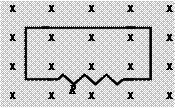
¦ 3. The figure shows a uniform magnetic field that is normal to the plane of a conducting loop, which has a resistance R. Which one of the following changes will cause an induced current to flow through the resistor?
(a) decreasing the area of the loop
(b) decreasing the magnitude of the magnetic field
(c) increasing the magnitude of the magnetic field
(d) rotating the loop through 90° about an axis in the plane of the paper
(e) all of the above
|
¦ 4. A conducting bar moves to the left at a constant speed v on two conducting rails joined at the left as shown. As a result of the bar moving through a constant magnetic field, a current I is induced in the indicated direction. Which one of the following directions is that of the magnetic field? (a) toward the right (d) into the page (b) toward the left (e) out of the page (c) parallel to the long axis of the bar |
|
|
ў 5. A 2.0-kg rod that has a length of 1.0 m and a resistance of 4.0 W slides with constant speed down a pair of frictionless vertical conducting rails that are joined at the bottom. Other than the rod, the rest of the circuit is resistanceless. A uniform magnetic field of magnitude 3.0 T is perpendicular to the plane formed by the rod and the rails as shown. Determine the speed of the rod. (a) 0.38 m/s (d) 5.6 m/s (b) 0.90 m/s (e) 8.7 m/s (c) 2.6 m/s |
|
¦ 6. A 0.45-m metal rod moves 0.11 m in a direction that is perpendicular to a 0.80-T magnetic field in an elapsed time of 0.036 s. Assuming that the acceleration of the rod is zero m/s2, determine the emf that exists between the ends of the rod.
(a) 1.1 V (d) 9.1 ґ 10–5 V
(b) 0.27 V (e) This cannot be determined without knowing the
(c) 0.076 V orientation of the rod relative to the magnetic field.
Section 22.3 Magnetic Flux
¦ 7. A 0.50-T magnetic field is directed perpendicular to the plane of a circular loop of radius 0.25 m.
What is the magnitude of the magnetic flux through the loop?
(a) 0.049 Wb (c) 0.20 Wb (e) zero Wb
(b) 0.098 Wb (d) 0.39 Wb
¦ 8. The Earth’s magnetic field passes through a square tabletop with a magnitude of 4.95 ґ 10-5 T and is directed at an angle of 165° relative to the normal of the tabletop. If the tabletop has 1.50-m sides, what is the magnitude of the magnetic flux through it?
(a) 1.08 ґ 10–4 Wb (c) 2.88 ґ 10–5 Wb (e) 3.30 ґ 10–6 Wb
(b) 7.11 ґ 10–5 Wb (d) 1.92 ґ 10–5 Wb
¦ 9. A circular copper loop is placed perpendicular to a uniform magnetic field of 0.50 T. Due to external forces, the area of the loop decreases at a rate of 1.26 ґ 10–3 m2/s. Determine the induced emf in the loop.
(a) 3.1 ґ 10–4 V (c) 1.2 ґ 10–3 V (e) 3.1 V
(b) 6.3 ґ 10–4 V (d) 7.9 ґ 10–3 V
ў 10. A conducting loop has an area of 0.065 m2 and is positioned such that a uniform magnetic field is perpendicular to the plane of the loop. When the magnitude of the magnetic field decreases to 0.30 T in 0.087 s, the average induced emf in the loop is 1.2 V. What is the initial value of the magnetic field?
(a) 0.42 T (c) 0.87 T (e) 1.9 T
(b) 0.75 T (d) 1.2 T
ў 11. A uniform magnetic field passes through two areas, A1 and A2. The angles between the magnetic field and the normals of areas A1 and A2 are 30.0° and 60.0°, respectively. If the magnetic flux through the two areas is the same, what is the ratio A1/A2?
(a) 0.577 (c) 1.00 (e) 1.73
(b) 0.816 (d) 1.23
ў 12. A 150-turn solenoid carries a current of 12 A. The radius of the solenoid is 0.050 m; and its length is 0.18 m. Determine the magnetic flux through the circular cross-sectional area at the center of the solenoid.
(a) 1.8 ґ 10–5 Wb (c) 4.3 ґ 10–4 Wb (e) 2.2 ґ 10–3 Wb
(b) 9.9 ґ 10–5 Wb (d) 7.0 ґ 10–4 Wb
Section 22.4 Faraday’s Law of Electromagnetic Induction
¦ 13. A magnetic field is directed perpendicular to the plane of a 0.15-m ґ 0.30-m rectangular coil consisting of 120 loops of wire. To induce an average emf of -1.2 V in the coil, the magnetic field is increased from 0.1 T to 1.5 T during a time interval Dt. Determine Dt.
(a) 0.053 s (c) 1.6 s (e) 7.6 s
(b) 0.13 s (d) 6.3 s

ў 14. The area of a 333-turn conducting coil is 7.85 ґ 10–3 m2. The resistance of the coil is 10.4 W. If the coil is oriented as shown in a magnetic field B, at what rate in T/s should the magnitude of B change to induce a current of 2.50 ґ 10–3 A in the coil?
(a) 0.0155 T/s (c) 0.228 T/s (e) 1.52 T/s
(b) 0.0996 T/s (d) 0.757 T/s
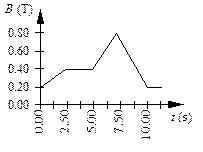
ў 15. A circular coil of wire has 25 turns and has a radius of 0.075 m. The coil is located in a variable magnetic field whose behavior is shown on the graph. At all times, the magnetic field is directed at an angle of 75° relative to the normal to the plane of a loop. What is the average emf induced in the coil in the time interval from t = 5.00 s to 7.50 s?
(a) -18 mV (d) -140 mV
(b) -49 mV (e) -180 mV
(c) -92 mV
Questions 16 through 19 pertain to the situation described below:
|
The figure shows a uniform, 3.0-T magnetic field that is normal to the plane of a conducting, circular loop with a resistance of 1.5 W and a radius of 0.024 m. The magnetic field is directed out of the paper as shown. Note: The area of the non-circular portion of the wire is considered negligible compared to that of the circular loop. |
|
¦ 16. What is the magnitude of the average induced emf in the loop if the magnitude of the magnetic field is doubled in 0.4 s?
(a) 0.43 V (c) 0.014 V (e) 0.038 V
(b) 0.65 V (d) 0.027 V
ў 17. What is the average current around the loop if the magnitude of the magnetic field is doubled in 0.4 s?
(a) 2.8 ґ 10–3 A, clockwise (d) 9.0 ґ 10–3 A, clockwise
(b) 4.5 ґ 10–3 A, clockwise (e) 9.0 ґ 10–3 A, counterclockwise
(c) 4.5 ґ 10–3 A, counterclockwise
¦ 18. If the magnetic field is held constant at 3.0 T and the loop is pulled out of the region that contains the field in 0.2 s, what is the magnitude of the average induced emf in the loop?
(a) 8.6 ґ 10–3 V (c) 2.7 ґ 10–2 V (e) 6.4 ґ 10–2 V
(b) 9.8 ґ 10–2 V (d) 5.4 ґ 10–2 V
ў 19. If the magnetic field is held constant at 3.0 T and the loop is pulled out of the region that contains the field in 0.2 s, at what rate is energy dissipated in R?
(a) 1.8 ґ 10–2 W (c) 3.8 ґ 10–3 W (e) 4.9 ґ 10–4 W
(b) 3.6 ґ 10–2 W (d) 2.7 ґ 10–4 W
Section 22.5 Lenz’s Law
Section 22.6 Applications of Electromagnetic Induction to the Reproduction of Sound
¦  20. A long, straight wire is in the same plane as a rectangular, conducting
loop. The wire carries a constant current I as shown in the figure.
Which one of the following statements is true if the wire is suddenly moved toward
the loop?
20. A long, straight wire is in the same plane as a rectangular, conducting
loop. The wire carries a constant current I as shown in the figure.
Which one of the following statements is true if the wire is suddenly moved toward
the loop?
(a) There will be no induced emf and no induced current.
(b) There will be an induced emf, but no induced current.
(c) There will be an induced current that is clockwise around the loop.
(d) There will be an induced current that is counterclockwise around the loop.
(e) There will be an induced electric field that is clockwise around the loop.

ў 21. A long, straight wire is in the same plane as a wooden, non-conducting loop. The wire carries an increasing current I in the direction shown in the figure.
(a) There will be no induced emf and no induced current.
(b) There will be a counterclockwise induced emf, but no induced current.
(c) There will be a clockwise induced emf, but no induced current.
(d) There will be a clockwise induced current in the loop.
(e) There will be a counterclockwise induced current in the loop.
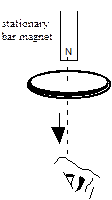 ¦ 22. A
metal ring is dropped from rest below a bar magnet that is fixed in position as
suggested in the figure. An observer views the ring from below. Which one of
the following statements concerning this situation is true?
¦ 22. A
metal ring is dropped from rest below a bar magnet that is fixed in position as
suggested in the figure. An observer views the ring from below. Which one of
the following statements concerning this situation is true?
(a) As the ring falls, an induced current will flow counterclockwise as viewed by the observer.
(b) As the ring falls, an induced current will flow clockwise as viewed by the observer.
(c) As the ring falls, there will be an induced magnetic field around the ring that appears counterclockwise as viewed by the observer.
(d) As the ring falls, there will be an induced magnetic field around the ring that appears clockwise as viewed by the observer.
(d) Since the magnet is stationary, there will be no induced current in the ring.
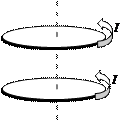 ў 23. Two conducting loops carry equal currents I in the
same direction as shown in the figure. If the current in the upper loop
suddenly drops to zero, what will happen to the current in the lower loop
according to Lenz’s law?
ў 23. Two conducting loops carry equal currents I in the
same direction as shown in the figure. If the current in the upper loop
suddenly drops to zero, what will happen to the current in the lower loop
according to Lenz’s law?
(a) The current in the lower loop will decrease.
(b) The current in the lower loop will increase.
(c) The current in the lower loop will not change.
(d) The current in the lower loop will also drop to zero.
(e) The current in the lower loop will reverse its direction.
|
¦ 24. A sheet of copper is pulled at constant velocity v from a region that contains a uniform magnetic field. At the instant shown in the figure, the sheet is partially in and partially out of the field. The induced emf in the sheet leads to the eddy current shown. Which one of the following statements concerning the direction of the magnetic field is true? (a) The magnetic field points to the right. (b) The magnetic field points to the left. (c) The magnetic field points into the paper. |
|
(d) The magnetic field points out of the paper.
(e) The direction of the magnetic field cannot be determined from the information given.
Questions 25 and 26 pertain to the situation described below:
|
A circuit is pulled with a 16-N force toward the right to maintain a constant speed v. At the instant shown, the loop is partially in and partially out of a uniform magnetic field that is directed into the paper. As the circuit moves, a 6.0-A current flows through a 4.0-W resistor. |
|
¦ 25. Which one of the following statements concerning this situation is true?
(a) The temperature of the circuit remains constant.
(b) The induced current flows clockwise around the circuit.
(c) Since the circuit moves with constant speed, the force F does zero work.
(d) If the circuit were replaced with a wooden loop, there would be no induced emf.
(e) As the circuit moves through the field, the field does work to produce the current.
ў 26. What is the magnitude of v?
(a) 1.5 m/s (c) 6.4 m/s (e) 12 m/s
(b) 3.0 m/s (d) 9.0 m/s
Section 22.7 The Electric Generator
|
¦ 27. A circular coil has 275 turns and a radius of 0.045 m. The coil is used as an ac generator by rotating it in a 0.500 T magnetic field, as shown in the figure. At what angular speed should the coil be rotated so that the maximum emf is 175 V? (a) 28 rad/s (d) 200 rad/s (b) 50 rad/s (e) 490 rad/s (c) 130 rad/s |
|
¦ 28. The angular speed of a motor is 262 rad/s. The back emf generated by the motor is 89.4 V. Assuming all other factors remain the same, determine the back emf if the angular speed of the motor is reduced to 154 rad/s.
(a) 32.3 V (c) 52.5 V (e) 152 V
(b) 44.7 V (d) 89.4 V
Questions 29 through 31 pertain to the situation described below:
|
A single conducting loop with an area of 2.0 m2 rotates in a uniform magnetic field so that the induced emf has a sinusoidal time dependence as shown.
|
|
¦ 29. With what angular frequency does the loop rotate?
(a) 0.16 rad/s (c) 0.52 rad/s (e) 1.26 rad/s
(b) 0.30 rad/s (d) 0.80 rad/s
¦ 30. What is the period of the induced current?
(a) 1.25 s (c) 3.75 s (e) 6.25 s
(b) 2.50 s (d) 5.00 s
ў 31. Determine the strength of the magnetic field in which the loop rotates.
(a) 0.5 T (c) 3.0 T (e) 18.8 T
(b) 2.4 T (d) 7.5 T
Section 22.8 Mutual Inductance and Self-Inductance
Ј 32. A closed loop carries a current that increases with time. Which one of the quantities listed below relates the emf induced in the loop to the rate at which the current is increasing?
(a) resistance of the loop (d) power dissipated by the loop
(b) capacitance of the loop (e) mutual inductance of the loop
(c) self-inductance of the loop
¦ 33. The current in a solenoid is decreased to one-half of its original value. Which one of the following statements is true concerning the self-inductance of the solenoid?
(a) The self-inductance does not change.
(b) The self-inductance increases by a factor of two.
(c) The self-inductance decreases by a factor of two.
(d) The self-inductance increases by a factor of four.
(e) The self-inductance decreases by a factor of four.
Ј 34. Determine the energy stored in a 95-mH inductor that carries a 1.4-A current.
(a) 0.38 J (c) 0.19 J (e) 0.066 J
(b) 0.27 J (d) 0.093 J
¦ 35. A solenoid with 1000 turns has a cross-sectional area of 7.0 cm2 and length of 25 cm. How much energy is stored in the magnetic field of the solenoid when it carries a current of 10.0 A?
(a) 0.10 J (c) 0.18 J (e) 0.36 J
(b) 2.8 J (d) 28 J
ў 36. Which one of the following combinations of units is equivalent to one henry?
(a) N Ч m Ч s/C (c) N Ч m Ч C2/s2 (e) N Ч m Ч s2/C2
(b) N Ч m Ч s2/C (d) N Ч m Ч C/s2
|
¦ 37. The figure shows a circular, conducting loop that is connected to a 5.0-V battery and a switch S. Immediately after the switch S is closed, the current through the loop changes at a rate of 15 A/s and the emf induced in the loop has a magnitude of 5.0 V. Determine the self-inductance of the coil. (a) 0.33 H (d) 3.0 H (b) 0.60 H (e) 5.0 H (c) 1.5 H |
|
|
Ј 38. Two coils share a common axis as shown in the figure. The mutual inductance of this pair of coils is 6.0 mH. If the current in coil 1 is changing at the rate of 3.5 A/s, what is the magnitude of the emf generated in coil 2? (a) 5.8 ґ 10-4 V (d) 1.5 ґ 10-2 V (b) 1.7 ґ 10-3 V (e) 2.1 ґ 10-2 V (c) 3.5 ґ 10-3 V |
|
¦ 39. A coil of wire with a resistance of 0.15 W has a self-inductance of 0.083 H. If a 5.0-V battery is connected across the ends of the coil and the current in the circuit reaches an equilibrium value, what is the stored energy in the inductor?
(a) 92 J (c) 16 J (e) 1.4 J
(b) 46 J (d) 4.1 J
Questions 40 through 44 pertain to the situation described below:
A 0.100-m long solenoid has a radius of 0.050 m and 1.50 ґ 104 turns. The current in the solenoid changes at a rate of 6.0 A/s. A conducting loop of radius 0.0200 m is placed at the center of the solenoid with its axis the same as that of the solenoid as shown.
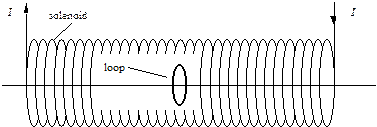
¦ 40. What is the magnetic flux through the small loop when the current through the solenoid is 2.50 A?
(a) 2.95 ґ 10-2 Wb (c) 2.95 ґ 10-4 Wb (e) 5.92 ґ 10-4 Wb
(b) 7.28 ґ 10-2 Wb (d) 4.38 ґ 10-4 Wb
¦ 41. Determine the mutual inductance of this combination.
(a) 1.8 ґ 10-4 H (c) 3.6 ґ 10-4 H (e) 5.9 ґ 10-4 H
(b) 2.4 ґ 10-4 H (d) 4.4 ґ 10-4 H
¦ 42. Determine the induced emf in the loop.
(a) 0.7 ґ 10–3 V (c) 2.8 ґ 10–3 V (e) zero volts
(b) 1.4 ґ 10–3 V (d) 5.6 ґ 10–3 V
Ј 43. Determine the induced emf in the loop if the loop is oriented so that its axis is perpendicular to the axis of the solenoid, instead of parallel.
(a) 0.7 ґ 10–4 V (c) 2.8 ґ 10–4 V (e) zero volts
(b) 1.4 ґ 10–4 V (d) 5.6 ґ 10–4 V
¦ 44. Determine the self-induced emf in the solenoid due to the changing current.
(a) 60 V (c) 130 V (e) 250 V
(b) 98 V (d) 180 V
Questions 45 through 51 pertain to the situation described below:
Two coils, 1 and 2, with iron cores are positioned as shown in the figure. Coil 1 is part of
a circuit with a battery and a switch.
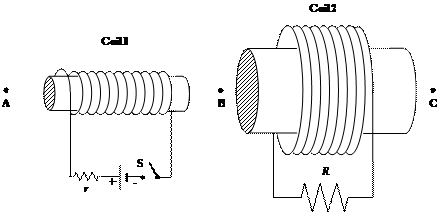
ў 45. Immediately after the switch S is closed, which one of the following statements is true?
(a) An induced current will flow from right to left in R.
(b) An induced current will flow from left to right in r.
(c) A magnetic field that points toward B appears inside coil 1.
(d) An induced magnetic field that points toward B appears inside coil 2.
(e) A current will pass through r, but there will be no current through R.
¦ 46. Assume the switch S has been closed for a long time. Which one of the following statements is true?
(a) An induced current will flow from right to left in R.
(b) An induced current will flow from left to right in r.
(c) A magnetic field that points toward B appears inside coil 1.
(d) An induced magnetic field that points toward B appears inside coil 2.
(e) A current will pass through r, but there will be no current through R.
¦ 47. Assume S has been closed for a long time. Which one of the following statements is true when coil 1 and its core are moved toward point B?
(a) There is no induced current in r.
(b) There is a magnetic field in coil 1 that points toward B.
(c) There is an induced current in R that flows from left to right.
(d) There is an induced current in R that flows from right to left.
(e) There is an induced magnetic field in coil 2 that points toward B.
ў 48. Assume that S has been closed for a long time. Which one of the following changes will not result in an induced current in coil 2 that flows from left to right through R.
(a) Coil 1 and its core are moved toward A. (d) The switch S is opened.
(b) Coil 2 and its core are moved toward B. (e) The iron core is removed from coil 1.
(c) Coil 2 and its core are moved toward C.
ў 49. Assume that S has been closed for a long time. Which one of the following changes will result in an induced magnetic field in coil 2 that points toward C?
(a) The switch S is opened. (d) Coil 1 and its core are moved toward B.
(b) The iron core is removed from coil 1. (e) Coil 2 and its core are moved toward C.
(c) Coil 1 and its core are moved toward A.
¦ 50. Assume that S has been closed for a long time. Which one of the following statements is true if S is suddenly opened?
(a) There is no induced current through R.
(b) There is no induced magnetic field in coil 2.
(c) There is an induced current in R that flows from right to left.
(d) There is an induced magnetic field in coil 2 that points toward C.
(e) There is an induced magnetic field in coil 2 that points toward B.
¦ 51. Assume that S has been closed for a long time. Which one of the following statements is true if coil 2 is moved toward C?
(a) There is an induced magnetic field in coil 2 that points toward B.
(b) There is an induced magnetic field in coil 2 that points toward C.
(c) There is an induced current in R that flows from right to left.
(d) There is an induced north pole at the right end of coil 2.
(e) There is no induced current in R.
|
ў 52. In the drawing, a coil of wire is wrapped around a cylinder from which an iron core extends upward. The ends of the coil are connected to an ac voltage source. After the alternating current is established in the coil, an aluminum ring of resistance R is placed onto the iron core and released. Which one of the following statements concerning this situation is false? (a) The induced current in the ring is an alternating current. (b) The temperature of the ring will increase. (c) At any instant, the direction of the induced current in the ring is in the same direction as that in the coil. |
|
(d) The induced magnetic field in the ring may by directed either upward or downward at an instant when the direction of the magnetic field generated by the current in the coil is upward.
(e) The ring may remain suspended at the position shown with no vertical movement of its center of mass.
Section 22.9 Transformers
¦ 53. The current in the secondary coil of a step-up transformer is 0.86 A when the current in the primary coil is 4.8 A. Determine the turns ratio, Ns/Np, of the transformer.
(a) 5.6 (c) 0.24 (e) 0.12
(b) 4.1 (d) 0.18
Ј 54. Which one of the following statements concerning transformers is false?
(a) Their operation makes use of mutual induction.
(b) They are an application of Faraday's and Lenz's laws.
(c) A transformer can function with either an ac current or a steady dc current.
(d) A transformer that steps down the voltage, steps up the current.
(e) A transformer that steps up the voltage, steps down the current.
¦ 55. A transformer changes 120 V across the primary to 1200 V across the secondary. If the secondary coil has 800 turns, how many turns does the primary coil have?
(a) 40 (c) 100 (e) 4000
(b) 80 (d) 400
ў 56. A transformer has 450 turns in its primary coil and 30 turns in its secondary coil. Which one of the following statements concerning this transformer is true?
(a) This is a step-up transformer.
(b) The turns ratio is 15 for this transformer.
(c) The ratio of the voltages Vs / Vp is 15 for this transformer.
(d) The ratio of the currents Is / Ip is 0.067 for this transformer.
(e) The power delivered to the secondary must be the same as that delivered to the primary.
Questions 57 and 58 relate to the following situation:
A small power plant produces a voltage of 6.0 kV and 150 A. The voltage is stepped up to 240 kV by a transformer before it is transmitted to a substation. The resistance of the transmission line between the power plant and the substation is 75 W.
¦ 57. What is the current in the transmission line from the plant to the substation?
(a) 3.8 A (c) 6.4 A (e) 7.5 A
(b) 5.2 A (d) 7.0 A
ў 58. What percentage of the power produced at the power plant is lost in transmission to the substation?
(a) 0.47 % (c) 0.34 % (e) 0.12 %
(b) 0.41 % (d) 0.23 %
Additional Problems
Questions 59 and 60 pertain to the statement and diagram below:
|
The figure shows a uniform magnetic field that is normal to the plane of the conducting loop of resistance R. Note: the area of the non-circular portion of the circuit is negligible compared to that of the loop. |
|
ў 59. Which entry in the table below correctly pairs the change in the system with the direction of the induced current through R?
change in the system direction of current through R
(a) decrease the area of the loop from top toward bottom
(b) rotate loop into the paper no induced current
(c) increase the area of the loop from bottom toward top
(d) decrease the magnitude of B from bottom toward top
(e) pull loop to the right from top toward bottom
¦ 60. Suppose that the radius of the loop is 0.500 m. At what rate must B change with time if the emf induced in the loop is 3p volts?
(a) 12.0 T/s (c) 24.0 T/s (e) 49.2 T/s
(b) 18.8 T/s (d) 37.7 T/s
¦ 61. A circular loop of copper wire with an area of 2.0 m2 lies in a plane perpendicular to a time-dependent magnetic field oriented as shown. The time-dependence of the field is shown in the graph.

Which one of the entries in the table below is incorrect?
Time Induced emf
(a) 1 s zero volts
(b) 4 s 2.5 V, counterclockwise
(c) 5 s 2.5 V, counterclockwise
(d) 7 s 10 V, clockwise
(e) 9 s 10 V, counterclockwise
Questions 62 through 64 pertain to the situation described below:
|
A loop is pulled with a force F to the right to maintain a constant speed of 8.0 m/s. The loop has a length of 0.15 m, a width of 0.080 m, and a resistance of 200.0 W. At the instant shown, the loop is partially in and partially out of a uniform magnetic field that is directed into the paper. The magnitude of the field is 1.2 T. |
|
¦ 62. What is the magnitude of the emf induced in the loop?
(a) zero volts (c) 1.4 V (e) 9.6 V
(b) 0.77 V (d) 4.9 V
¦ 63. What is the induced current in the loop?
(a) 0.048 A (c) 7.2 ґ 10-3 A (e) zero amperes
(b) 0.024 A (d) 3.8 ґ 10-3 A
ў 64. Determine the magnitude of the force F required to pull the loop.
(a) 1.3 ґ 10-4 N (c) 3.7 ґ 10-4 N (e) 9.0 ґ 10-4 N
(b) 2.1 ґ 10-4 N (d) 6.8 ґ 10-4 N

Questions 65 through 69 pertain to the situation described below:
A loop with a resistance of 2.0 W is pushed to the left at a constant speed of 4.0 m/s by a 32 N force. At the instant shown in the figure, the loop is partially in and partially out of a uniform magnetic field. An induced current flows from left to right through the resistor. The length and width of the loop are 2.0 m and 1.0 m, respectively.
¦ 65. What is the direction of the magnetic field?
(a) to the left (c) out of the paper (e) toward the top of the page
(b) to the right (d) into the paper
ў 66. Determine the magnitude of the induced current through the resistor.
(a) 2.0 A (c) 8.0 A (e) 32 A
(b) 4.0 A (d) 16 A
¦ 67. Determine the magnitude of the induced emf in the loop.
(a) 2.0 V (c) 8.0 V (e) 16 V
(b) 4.0 V (d) 12 V
¦ 68. Determine the magnitude of the uniform magnetic field.
(a) 2.0 T (c) 6.0 T (e) 12 T
(b) 4.0 T (d) 8 T
¦ 69. At what rate is energy dissipated by the resistor?
(a) 130 W (c) 32 W (e) 8.0 W
(b) 96 W (d) 16 W
Questions 70 through 72 pertain to the situation described below:
A flexible, circular conducting loop of radius 0.15 m and resistance 4.0 W lies in a uniform magnetic field of 0.25 T. The loop is pulled on opposite sides by equal forces and stretched until its enclosed area is essentially zero m2, as suggested in the drawings. It takes 0.30 s to close the loop.

¦ 70. Determine the magnitude of the emf induced in the loop.
(a) 1.2 ґ 10-1 V (c) 1.8 ґ 102 V (e) 5.9 ґ 102 V
(b) 1.8 ґ 10-2 V (d) 5.9 ґ 10-2 V
¦ 71. At what rate is heat generated in the loop?
(a) 3.6 ґ 10-3 W (c) 8.7 ґ 104 W (e) 8.1 ґ 10-5 W
(b) 8.7 ґ 10-4 W (d) 8.1 ґ 105 W
¦ 72. Which one of the following phrases best describes the direction of the induced magnetic field generated by the current induced in the loop while the loop is being stretched?
(a) clockwise (c) into the page (e) The induced field is zero.
(b) counterclockwise (d) out of the page
Материалы на данной страницы взяты из открытых источников либо размещены пользователем в соответствии с договором-офертой сайта. Вы можете сообщить о нарушении.